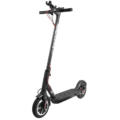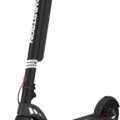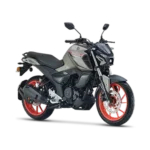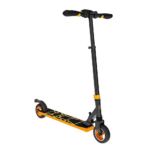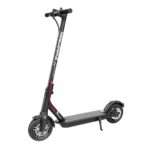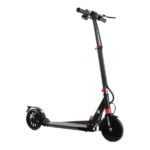- Home
- Scooters
- Electric Scooters
- Swagtron 5 Elite
Swagtron 5 Elite
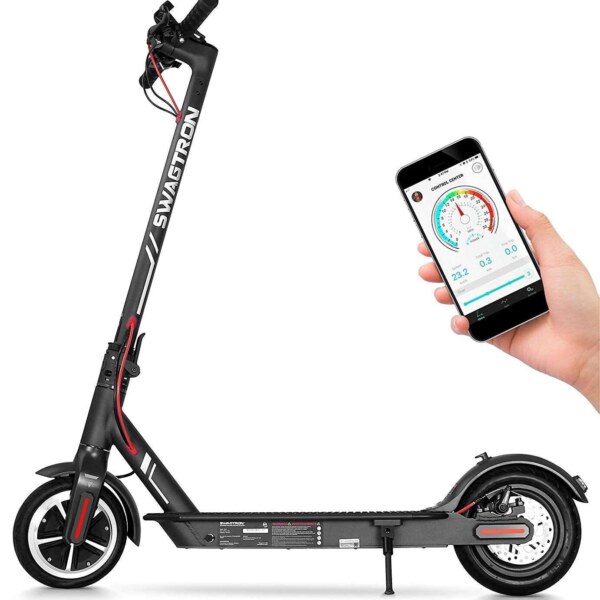

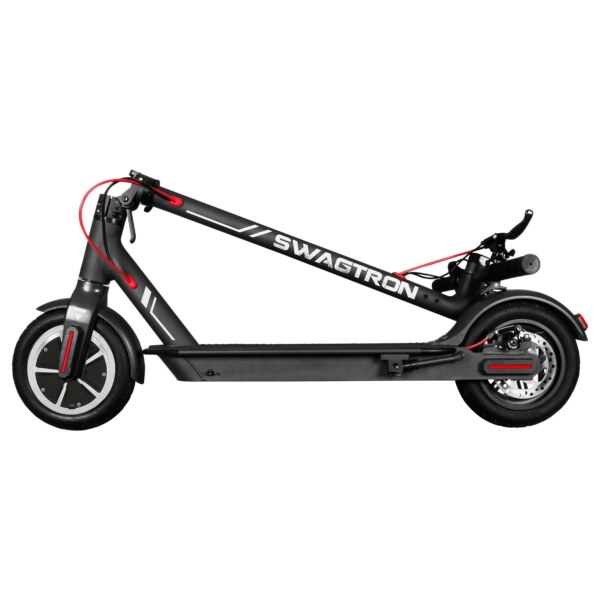
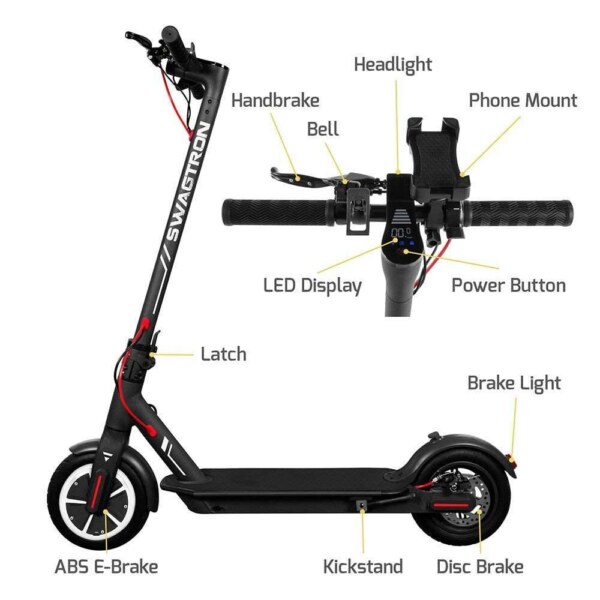
- Battery Range: 11 miles (18 km)
- Top Speed: 18 mph (29 km/h)
- Motor Power: 250 W
- Weight Capacity: 320 lb (145 kg)
- Charging Time: ~3.5 h
- Scooter Weight: 26.0 lb (11.8 kg)
PROS
- 18 mph (29 km/h) class speed
- App connectivity with lock
- Rear disc + e-brake
- Folds to 41.5 × 17 × 19 in
- 8.5″ tires for urban roads
CONS
- Short range for commuting
- No suspension
- Battery capacity not disclosed
- IP rating not specified
Key Takeaways
- The Swagtron 5 Elite is a lightweight, folding electric scooter designed for short city trips.
- It features a front-hub motor, quick folding mechanism, and LED display for speed and battery monitoring.
- With a range of up to 11 miles, it offers three riding modes and a gentle throttle for easy handling.
- This scooter is ideal for first-time riders and students but struggles with steep hills and long-distance commutes.
- Overall, the Swagtron 5 Elite excels in portability, making it great for city commuting and multi-modal travel.
Table of contents
- What Is the Swagtron 5 Elite?
- How the Swagtron 5 Elite Works
- Key Specifications
- Design & Build Quality
- Performance Fundamentals
- Battery, Range & Efficiency
- Ride Quality & Comfort
- Braking & Safety Features
- Portability & Daily Usability
- Maintenance & Care
- Weather & Seasonal Considerations
- Swagtron 5 Elite vs Alternatives
- Who the Swagtron 5 Elite Is (and Isn’t) For
- Swagtron 5 Elite Ownership Tips
- Final Thoughts
The Swagtron 5 Elite is a lightweight, folding commuter scooter built for short city trips. It shines on flat routes, and it stays easy to carry up a few stairs. You get steady speed, a quick fold, and simple controls. So first-time riders and students feel at home fast.
What Is the Swagtron 5 Elite?
The Swagtron 5 Elite. sometimes listed as the Swagger 5 Elite or SG-5 Elite. is a compact electric scooter for daily use. It folds in seconds, slips under a desk, and weighs about 26 lb (11.8 kg). A front-hub motor does the driving, and a clear LED display shows speed and battery bars. You can pair a phone for basic settings and cruise control. So the learning curve stays short.
It sits in the “light commuter” camp. That means modest power, a small battery, and easy living day to day. If you want a similar vibe with a slight twist, take a look at the Swagtron 5T. And if you prefer a bump in pep within the same family, the Swagtron SG-5 Boost earns a glance.
How the Swagtron 5 Elite Works
Power comes from a front hub motor. You press a thumb throttle on the right to go, and you lift off to coast. The controller meters energy from the battery to the motor. So power builds smoothly from a stop and stays predictable in turns.
The battery is a lithium-ion pack at 37 V. A built-in management system balances cells and protects against faults like over-charge or over-heat. The LED display sits at the center of the bars. It shows speed, battery level, and a pairing icon. You can choose among three ride modes. Then you can hold a steady speed with cruise control on long straight sections. Tap throttle or pull brake to cancel it.
Stopping relies on a mechanical rear disc. Motor drag helps as you roll off the throttle. So weight shifts back before the pads bite, and the lever feels light at first, then firmer as you pull.
Key Specifications
| Category | Item | Value |
|---|---|---|
| General | Model Name | Swagtron (Swagger) 5 Elite |
| Scooter Type | Folding electric kick scooter | |
| Rider Height Range | 4’–6’6” (120–200 cm) | |
| Max Rider Weight | 320 lb (145 kg) | |
| Performance & Power | Motor | Front hub motor, 250 W nominal |
| Top Speed | 18 mph (29 km/h) | |
| Riding Modes | 3 modes + cruise control | |
| Typical Terrain | Hard surfaces, flat roads, gentle ramps | |
| Battery, Charging & Electrical | Battery Type | Lithium-ion |
| Nominal Voltage | 37 V | |
| Capacity (Energy) | 158.4 Wh | |
| Rated Range | 11 miles (17.7 km) | |
| Battery Management | Cell balancing, over/under-voltage, thermal protection, auto shutoff | |
| Build & Dimensions | Frame | Aluminum alloy |
| Tires | Air-filled rubber, front motorized, rear passive | |
| Unfolded Size | 41.5 × 17 × 45.3 in (1054 × 436 × 1150 mm) | |
| Folded Size | 41.5 × 17 × 19 in (1054 × 436 × 480 mm) | |
| Vehicle Weight | ~26 lb (11.8 kg) | |
| Safety & Control | Brakes | Rear disc, motor assist on roll-off |
| Lights | LED headlight and rear light | |
| Bell | Handlebar bell | |
| IP Rating | Not published | |
| Features & Extras | Display | LED speedometer with battery gauge and pairing icon |
| App | iOS/Android pairing, cruise control | |
| Convenience | Kickstand, phone mount option | |
| Warranty & Compliance | Warranty | 1-year limited hardware warranty (region dependent) |
| Compliance | Conforms to standard consumer electronics requirements | |
| Charger | 42 V, 1.5 A, 100–240 V input, ~3.5 h charge time |
Notes: Dimensions, weight, speed, range, voltage, and load ratings reflect published figures. Real-world results vary with rider mass, route grade, surface, temperature, and wind.
Design & Build Quality
The frame uses aluminum alloy, so the scooter stays light yet sturdy. The folding joint locks with a collar and a latch. Then the stem hooks to the rear fender for carry time. The deck has a flat, grippy surface that supports a staggered stance. Edges stay clean on shoes, and the under-deck layout keeps cables tidy.
The cockpit is simple. A central LED display shows speed in large digits, with battery bars under it. A small icon confirms phone pairing. The throttle sits on the right. The brake lever sits on the left next to a bell. So you can ping with your thumb without moving your grip. Wires run down the stem with strain relief at the bends. The charging port sits on the side of the deck for easy access.
Fit and finish match the class. The latch closes with a firm click, and the collar tightens without wiggle when adjusted right. Expect a touch of stem flex when you load the bars on rough patches. That is normal for light, fast-folding designs. Check the latch tension after the first week. Then recheck monthly. The deck cleans up with a damp cloth, and the paint resists small scuffs from daily use.
Performance Fundamentals
Starts feel calm and consistent. The front motor pulls you off the line without drama, and it reaches neighborhood speed with ease. Mode 1 keeps things tame for crowded paths. Mode 2 fits mixed sidewalks and calm streets. Mode 3 unlocks the full 18 mph (29 km/h) for open sections. So you can match the route to the mode.
Stability stays solid at 10–15 mph. The wheelbase is moderate, and the deck rides low, so your center of gravity sits down in the frame. At top speed the scooter prefers smooth pavement. Keep a relaxed grip, and keep your weight light on the front over cracks. The motor adds weight to the front wheel, so larger joints kick a bit more there. Bend your knees over expansion gaps and grates.
Hills call for realistic expectations. Two to four percent feels easy. Seven to ten percent slows the scooter, and it may need a small kick at the start on steeper blocks. Short city rises in Mode 3 work fine. For longer climbs on hot days, watch for heat fade. If power tapers, back off for a minute. Then continue at a calmer pace.
Battery, Range & Efficiency
The pack runs at 37 V with a rated 158.4 Wh. That matches the scooter’s light build and keeps charge time short. The stated range is 11 miles (17.7 km). In practice a lighter rider on warm, flat pavement gets near that number at mixed speeds. A 200 lb (91 kg) rider on cool mornings with frequent stops often sees 6–9 miles (9.5–14.5 km). So plan rides with a little margin.
Think in layers. Flat routes, calm winds, and warm cells extend distance. Cold weather, hills, and headwinds shorten it. Smooth throttle inputs help, and cruise control trims wasted spikes on long straight runs. Fresh tires at the right pressure cut rolling losses, and they keep handling predictable.
Charging is simple. The 42 V, 1.5 A charger takes roughly three and a half hours from low to full. Top up at work or class if you need a longer day. Store and charge the scooter at room temperature. Lithium cells like mild conditions. So skip hot trunks and unheated sheds. For storage longer than a week, leave the pack around half. Then check it monthly.
Ride Quality & Comfort
Comfort here comes from the tire air volume and the low deck. There is no spring or hydraulic suspension. So the tires do the work. Air-filled rubber at both ends smooths small cracks and seams. Lower pressure adds grip and comfort, and higher pressure reduces pinch-flat risk. Aim for the maker’s range and adjust a touch for rider weight and route.
The deck sits low, which helps stability and foot feel. A wide stance with your front foot near the head tube and your rear foot angled on the back half works well. Bar height suits average riders, and round grips feel natural in the hands. Stem flex stays modest on clean ground, and you may feel a bit of shake on broken concrete. Keep elbows soft and knees bent over rough blocks. That small change pays off.
Noise stays low. The motor hums, and the tires whisper on clean asphalt. Rattles point to loose hardware. So grab a small hex key and snug things up after the first week. Then rides stay quiet.
Braking & Safety Features
The rear disc does most of the stopping. It reacts early in the lever pull, then firms up mid-stroke. Motor drag adds a smooth slowdown when you release throttle. So weight shifts before the pads bite hard. Use two fingers for quick stops, and load your rear foot to keep the tire planted.
Lights check the day-and-night basics. A bright LED headlight helps you see and be seen. A rear light marks your position to cars and cyclists. Add a small clip-on if you ride unlit streets often. The bell is loud enough for shared paths, and it sits where your thumb reaches it without fuss.
Water protection has no formal rating listed. Ride with care on wet streets. Braking distances grow on water and grit, and painted lines turn slick. Avoid deep puddles near the deck ports. After wet rides, towel the scooter and test the brake in a safe space before you mix with traffic again.
Portability & Daily Usability
Portability is the point. At about 26 lb (11.8 kg), most riders can carry it up a flight of stairs. The folded size is 41.5 × 17 × 19 in (1054 × 436 × 480 mm). So it fits tight car trunks and train gaps. The latch closes fast, and the hook keeps the stem locked to the rear fender during carry. Practice the fold a few times at home. Then you can do it one-handed while you hold a bag.
Storage is easy under a desk or along a closet wall. Use the kickstand for quick stops, and angle the scooter so the deck is not a trip hazard. For short outside errands, thread a U-lock through the rear frame and wheel. Add a cable around the stem if you must leave it for a bit. Skip overnight street parking to keep it safe and dry.
Daily rhythm becomes simple. Mode 2 covers mixed routes. Mode 3 suits clear streets. Cruise control helps on long flats. Keep a compact pump and a pressure gauge at home. Then set tire pressure weekly, and you will notice smoother steering and better range.
Maintenance & Care
Create a quick routine. It keeps rides safe and quiet.
- Before each ride: Check tire pressure, spin wheels to spot debris, and pull the brake once to feel pad bite.
- Weekly: Check latch tension, lever clamp bolts, axle nuts, and fender screws. Snug them, then wipe dust from deck and lights.
- Monthly: Inspect brake pads and rotor. Clean the rotor with isopropyl alcohol if you hear squeal. Confirm the display buttons and throttle spring back cleanly.
- Battery habits: Charge indoors at room temperature. Unplug after a full cycle. For longer breaks, store around half charge and in a dry, cool room.
- App and updates: Pair your phone for cruise control and settings. Update when the scooter is cool, and test a short ride right after.
New vibrations rarely fix themselves. Track the source and address it early. A tiny rattle usually means a bolt that wants a quarter-turn. A soft lever often means the caliper needs a quick realignment. Work in small steps, and test in a safe lot.
Weather & Seasonal Considerations
Rain changes grip and distance. Ride slower, and leave more space. Painted lines and metal plates turn slick first. So cross them straight and gently. Water and electronics do not mix. So keep the deck dry and skip deep puddles. If you get caught in a shower, towel the scooter before you charge it.
Heat raises battery and motor temps. Park in the shade, and skip hot trunks. On steep climbs during a heat wave, power can fade. Ease off for a minute. Then continue at a calmer pace. Cold weather trims range. So plan shorter loops in winter, charge indoors, and ride at a steady pace to keep the pack warm enough.
Wind matters more than most expect. A headwind cuts speed and range. So drop to Mode 2 and sit a little lower on the bars. A tailwind on the way back always feels great, and it often saves a bar or two of battery.
Swagtron 5 Elite vs Alternatives
Light commuter class. The Swagtron 5 Elite wins when you care about low weight and quick folds. It is easier to carry than many 30–40 lb models, and it takes less space in a trunk. So stairs and train transfers feel simple.
Mid-power commuter class. Heavier scooters add stronger motors and bigger batteries. You gain hill speed and range, and you get a more planted ride at the top of the dial. But you pay with extra mass, larger folded size, and longer charge times.
Performance class. Dual-motor scooters bring fast launches and high top speed. They add hydraulic brakes, large tires, and suspension travel. Then they cross 60 lb (27 kg) and up. That weight fits long suburban rides and garage storage, not third-floor walk-ups.
Off-road class. Knobby tires and long-travel suspension handle dirt and roots. That setup is fun on trails, and it is overkill for urban errands. You will feel the weight every time you lift it.
So where does this scooter land. It works best as a nimble, low-maintenance commuter for short to medium city routes. It is not built for steep hills or long tours. Instead it rewards smooth streets, steady cruising, and easy storage.
Who the Swagtron 5 Elite Is (and Isn’t) For
Great for:
- City commutes under 6–8 miles round-trip. Ride to a station, fold, hop on a train, then finish the last mile on wheels. The short charge time helps you top up at work.
- Students and campus riders. Quick starts, low weight, and easy storage in dorms or labs. The bell and lights handle path etiquette and late classes.
- Multi-modal travelers. The folded size fits bus aisles and car trunks. You can combine it with rideshare or rail without stress.
- First-time riders. Clear modes, gentle throttle, and predictable brakes. Skills build fast, and confidence follows.
Not ideal for:
- Very steep neighborhoods. Long climbs above 10% grade slow the scooter a lot. A stronger commuter handles that terrain better.
- Daily long-range routes. If you need 15–25 miles without a plug, step up to a larger battery.
- Rough roads or gravel. Air-filled tires help, and no suspension means you will feel broken pavement. Larger tires and suspension fit those routes better.
Swagtron 5 Elite Ownership Tips
A few habits keep the scooter tight and safe.
- Tires: Check pressure weekly with a good gauge. Set both wheels in the maker’s range. Then adjust a hair for comfort or efficiency.
- Brakes: After washing or rain, pull the lever hard once in a safe lot. This dries pads and rotor. If the lever feels spongy, realign the caliper and snug the bolts evenly.
- Folding joint: Keep the latch clean. Grit near the joint creates play. Wipe it after wet rides. Then recheck tension monthly.
- Battery: Charge indoors, unplug after full, and store around half for breaks longer than a week. Room temperature is best.
- Lights: Test them before night rides. A tiny clip-on backup light in your bag adds peace of mind.
Final Thoughts
The Swagtron 5 Elite is built for simple travel and easy storage. It is light, compact, and quick to fold. The motor delivers smooth launches and calm cruising. Brakes feel predictable, and the display stays readable in a glance. The battery charges fast, and the pack size matches daily loops.
There are trade-offs. You accept modest hill pace and modest range to gain portability and ease of use. For many city riders, that is the right balance. Keep tires at pressure, keep the latch tight, and charge in a mild room. Then the scooter delivers a clean, low-stress commute.
Specifications
General
| Model The Model specifies the exact version or name of the scooter. It helps identify its unique design, features, and specifications within the manufacturer’s product line. Knowing the model makes it easier to compare options, find compatible accessories, or look up support information. | 5 Elite |
| Brand The Brand identifies the manufacturer or company that designs and produces the scooter. A trusted brand is a sign of quality, reliability, and good customer support. Well-known brands often have higher standards for safety, performance, and after-sales service, giving you more confidence in your purchase. | Swagtron |
| Release Date The Release Date indicates when the scooter model was officially launched on the market. This helps you know how current the design, technology, and features are. A newer release date often means updated components, improved performance, and the latest safety or smart features. | 18 November 2025 |
| Recommended Age Recommended Age indicates the minimum age range that the scooter is designed for, based on safety, size, and ease of use. Following the recommended age helps ensure that riders can handle the scooter’s speed, weight, and controls comfortably and safely. Always check local laws and use protective gear, especially for younger riders. | +16 |
Performance & Power
| Motor Power (Wattage) What it means: The motor power, measured in watts (W), shows how strong the scooter’s electric motor is. Why it matters: Higher wattage usually means better acceleration, more torque, and improved performance on hills or rough terrain. For example, a 250W motor is good for flat city roads and light riders, while a 500W or 1000W motor provides more power for faster speeds or climbing steep inclines. | 250 W front hub motor |
| Top Speed The Top Speed indicates the maximum speed that the scooter can reach under optimal conditions. It’s usually measured on level ground with a fully charged battery and an average rider weight. A higher top speed allows you to travel longer distances faster, but always ensure you ride within legal speed limits and your personal comfort zone for safety. | 18 mph (29 km/h) |
| Battery Capacity Battery Capacity refers to the total amount of energy the scooter’s battery can store, usually measured in ampere-hours (Ah) or watt-hours (Wh). A higher battery capacity means you can ride longer distances on a single charge, reducing the need for frequent recharging. Keep in mind that actual range can vary depending on rider weight, terrain, speed, and weather conditions. | 36 V — Not specified Ah (Not specified Wh) |
| Estimated Range per Charge The Estimated Range per Charge indicates the average distance the scooter can travel on a single full battery charge. This range is calculated under optimal conditions, such as flat terrain, moderate speed, and average rider weight. Real-world range may vary depending on riding style, terrain, weather, and load. A longer range means fewer recharges and greater freedom for longer trips. | 11 miles (18 km) |
| Hill Climb Ability Hill Climb Ability describes the maximum incline or slope that the scooter can handle while maintaining stable performance. It’s typically expressed as a percentage or in degrees. A higher hill climb rating means the scooter can tackle steeper hills without losing too much speed or power. Actual climbing performance may vary based on rider weight, battery charge, and terrain conditions. | Not specified |
| Drive System The Drive System refers to how power from the motor is delivered to the wheels. Electric scooters typically use either a hub motor (directly integrated into the wheel) or a chain/belt drive system. A high-quality drive system ensures smooth acceleration, efficient power transfer, and low maintenance. The choice of drive system affects performance, noise level, and overall ride experience. | Front hub (FWD) |
Charging & Electrical
| Charging Time Charging Time indicates how long it takes to fully recharge the scooter’s battery from empty to 100% using the standard charger provided. Faster charging means less downtime and more time on the road. Actual charging time may vary slightly depending on battery capacity, charger output, and environmental conditions. | Approx. 3.5 hours |
| Battery Type Battery Type refers to the specific technology used in the scooter’s battery, which affects performance, lifespan, weight, and charging time. Most modern electric scooters use high-quality lithium-ion (Li-ion) batteries because they offer a good balance of energy density, durability, and low maintenance. A reliable battery type ensures consistent power delivery and longer riding ranges. | Lithium-ion pack with BMS |
| Removable Battery A Removable Battery means the battery pack can be easily detached from the scooter for convenient charging and replacement. This feature allows you to charge the battery separately, swap it with a spare for extended range, or securely store it indoors in extreme weather. Removable batteries add flexibility and make it easier to keep your scooter powered up wherever you are. | Non-removable internal battery (fixed pack) |
| Regenerative Braking Regenerative Braking is an energy-saving feature that converts some of the energy normally lost during braking back into battery power. When you slow down or brake, the motor works in reverse to generate electricity, which helps extend the scooter’s range and improves overall efficiency. This system also reduces wear on traditional brake components, leading to lower maintenance over time. | Yes (via electronic brake) |
| Lighting Lighting refers to the built-in front and rear lights that enhance visibility and safety when riding in low-light conditions or at night. Good lighting helps you see the road ahead and ensures that other road users can see you. Many scooters include LED headlights, taillights, and sometimes brake lights or side reflectors for added safety and compliance with local traffic regulations. | LED headlight + rear LED/brake + reflectors |
Build & Dimensions
| Scooter Weight Scooter Weight refers to the total weight of the scooter when fully assembled, including the battery. This affects how easy it is to carry, lift, and store the scooter when not in use. A lighter scooter is more portable and convenient for commuting, especially if you need to carry it upstairs or onto public transport. Keep in mind that a sturdy frame and quality components may add to the weight but also contribute to better durability and ride stability. | 26.0 lb (11.8 kg) |
| Maximum Rider Weight Maximum Rider Weight indicates the highest rider weight that the scooter is designed to safely support while maintaining optimal performance and stability. Staying within this limit helps ensure reliable acceleration, braking, and climbing ability, and it protects the frame, suspension, and motor from excessive strain. Exceeding the recommended limit may reduce performance and increase wear on components. | 320 lb (145 kg) |
| Deck Size Deck Size refers to the dimensions of the scooter’s standing platform. A wider and longer deck provides more foot space, allowing you to stand comfortably and adjust your stance while riding. A well-sized deck improves balance and stability, especially on longer rides or at higher speeds. Compact decks, on the other hand, help keep the scooter lightweight and portable. | Low deck commuter geometry; compact footprint |
| Handlebar Height Handlebar Height refers to the distance from the deck to the handlebars, which affects your riding posture and comfort. An appropriate handlebar height helps you maintain good balance, reduces strain on your back and arms, and makes steering more comfortable. Some scooters have adjustable handlebars to fit riders of different heights, while others have a fixed height for a streamlined design. | Fixed |
| Folding Mechanism The Folding Mechanism describes how easily and securely the scooter can be folded for carrying and storage. A well-designed folding system lets you quickly collapse the scooter into a compact size, making it convenient to transport on public transit, store under a desk, or fit into a car trunk. Look for sturdy latches and safety locks to ensure the scooter stays firmly in place when folded or unfolded. | Quick-fold latch |
| Dimensions Folded Dimensions indicate the size of the scooter when it’s fully folded. This measurement shows how much space the scooter will take up when stored or carried, making it easier to check if it will fit in your car trunk, under a desk, or in a closet. Compact folded dimensions are ideal for commuters who need to bring their scooter on public transport or store it in tight spaces. | Unfolded: 41.5 × 17 × 45.3 in (105.4 × 43.2 × 115.1 cm); Folded: 41.5 × 17 × 19 in (105.4 × 43.2 × 48.3 cm) |
| Material Material refers to the primary construction materials used for the scooter’s frame and key components. High-quality materials like aircraft-grade aluminum, reinforced steel, or durable composites provide strength, stability, and a lighter overall weight. A sturdy material ensures the scooter can handle daily wear and tear while maintaining safety and performance. | Aluminum alloy |
Safety & Control
| Brake Type(s) Brake Type(s) describe the braking systems the scooter uses to help you slow down or stop safely. Common brake types include mechanical brakes (like drum or disc brakes), electronic brakes, and foot brakes. Many scooters combine multiple braking systems for added safety and shorter stopping distances. The type and quality of brakes affect your control, especially when riding at higher speeds or on slopes. | Front electronic + rear disc |
| Suspension Suspension refers to the system that absorbs shocks and vibrations while riding, providing a smoother and more comfortable ride over uneven or rough surfaces. Scooters may have front suspension, rear suspension, or dual suspension for better shock absorption and stability. Good suspension helps reduce rider fatigue and improves control, especially when riding on bumpy roads or off-road paths. | None |
| Tire Type Tire Type refers to the kind of tires the scooter uses, which directly affects ride comfort, traction, and maintenance. Common types include solid (airless) tires, pneumatic (air-filled) tires, or hybrid options. Pneumatic tires offer better shock absorption and a smoother ride on rough surfaces, while solid tires are puncture-proof and require less upkeep. The right tire type helps ensure safe handling and a comfortable ride in different conditions. | 8.5″ pneumatic or solid (varies by region) |
| Tire Size Tire Size indicates the diameter and width of the scooter’s tires, which affect ride comfort, stability, and how well the scooter handles different terrains. Larger tires generally offer better shock absorption and a smoother ride over bumps and rough surfaces, while smaller tires keep the scooter lighter and more portable. Choosing the right tire size helps ensure a balance between agility and comfort. | 8.5-inch |
| Kickstand The Kickstand is a built-in stand that allows you to park your scooter upright when it’s not in use. A sturdy kickstand keeps the scooter stable and prevents it from tipping over, protecting it from scratches and damage. It also makes storing and accessing your scooter more convenient, whether you’re at home, work, or on the go. | Side kickstand |
| Water Resistance Rating Water Resistance Rating indicates how well the scooter is protected against water and moisture, usually shown as an IP (Ingress Protection) rating. This rating helps you understand whether the scooter can handle light rain, splashes, or wet roads without damage. While most scooters are not fully waterproof, a good water resistance rating adds peace of mind when riding in changing weather conditions. Always avoid deep puddles or submerging the scooter to protect its electrical components. | Not specified |
Features & Extras
| Display/Console The Display (or Console) shows important real-time information about your ride, helping you monitor your scooter’s status at a glance. Typical displays show speed, battery level, distance traveled, and riding mode. Some models also include additional features like Bluetooth connectivity, app integration, or backlighting for better visibility at night. A clear and easy-to-read display enhances safety and convenience on every trip. | LED display with speed, battery, mode |
| Ride Modes Ride Modes refer to the different speed and power settings you can choose to match your riding style or road conditions. Common modes include eco for maximum range and energy efficiency, standard for everyday balance, and sport or turbo for higher speed and stronger acceleration. Switching between ride modes allows you to customize performance, conserve battery, and ride safely in various environments. | 3 modes (Eco/Standard/Sport) |
| Smart App Connectivity Smart App Connectivity lets you pair your scooter with a dedicated mobile app via Bluetooth. Using the app, you can monitor real-time ride stats like speed, battery level, and range, adjust settings such as ride modes or cruise control, lock the scooter for added security, and sometimes receive firmware updates. This feature adds convenience and allows you to personalize your riding experience right from your smartphone. | Swagger app (Bluetooth): lock, modes, stats |
| Anti-Theft System The Anti-Theft System helps protect your scooter from unauthorized use or theft. This feature can include built-in alarms, electronic motor locks, GPS tracking, or remote locking through a mobile app. A good anti-theft system provides peace of mind when parking your scooter in public spaces, adding an extra layer of security to safeguard your investment. | App lock |
| Cruise Control Cruise Control allows you to maintain a steady speed without continuously holding the throttle. This feature makes longer rides more comfortable by reducing hand fatigue and providing a smoother, more relaxed riding experience — especially on flat, open roads or bike lanes. For safety, cruise control can usually be easily activated or deactivated while riding. | Yes (cruise control) |
| Accessories Included Accessories Included lists the additional items that come with the scooter to enhance your riding experience and convenience. Common accessories may include a charger, kickstand, bell, lights, phone holder, or carrying strap. These extras add value by making your scooter safer, easier to use, and ready to ride straight out of the box. | Scooter, charger (42 V, amperage not specified), tools, manual |
Warranty & Compliance
| Warranty Period The Warranty Period indicates how long the manufacturer guarantees the scooter against defects in materials and workmanship under normal use. A good warranty provides peace of mind, showing the brand’s confidence in its product quality. Always check what parts are covered, such as the frame, battery, and motor, and follow the maintenance guidelines to keep your warranty valid. | 12 months (region-dependent) |
| Certifications Certifications confirm that the scooter meets specific safety, quality, and environmental standards set by recognized organizations or regulatory bodies. Common certifications may include CE, RoHS, UL, or other local compliance marks, depending on your region. These certifications ensure that the scooter is manufactured to high standards and is safe and legal to use in your country. | Local micromobility regulations |



